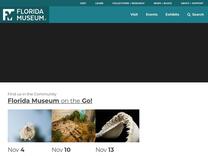A Remote Possibility – Invertebrate Zoology https://www.floridamuseum.ufl.edu/iz/2020/05/20/a-remote-possibility/
I hope this post finds you safe and healthy. Â Here at the Florida Museum, things have been shut down for a while, and it has given us a great opportunity to tackle all the parts of our job that our job prevents us from doing. Â Now that we are not out in the field, or physically in the museum answeri
feelings be known via an insistent beeping which Rob heard one morning on his way to man

